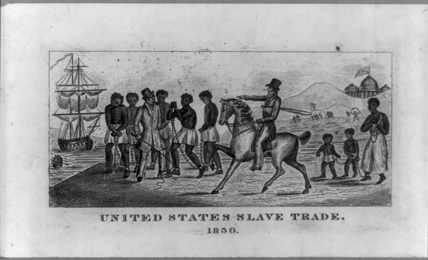
This image depicts the domestic slave trade as it existed in antebellum Baltimore, circa 1830.
The city of Baltimore witnessed widespread protests in the days following the death of Freddie Gray, an African American man who suffered a fatal spinal cord injury while in police custody. On April 27, the day of Gray’s funeral, the mostly nonviolent protests gave way to angry confrontations with police, looting of stores, and burning of vehicles and buildings. Maryland’s governor declared a state of emergency. The mayhem is now over, but the long-haul challenges remain, which begs a look at the long-developing “root causes.”
The unrest was centered in a poverty-stricken West Baltimore neighborhood that has seen more than its share of woes.Over the last half of the 20th century, such problems as disruption from urban renewal and highway construction; violent crime, drug use, and mass incarceration; and loss of jobs from deindustrialization all have had negative impacts on Baltimore’s minority communities. Resentment and distrust toward the police provided the flashpoint.
For over a century, housing policies at the federal, state, and local level have resulted in racial and socioeconomic segregation in cities like Baltimore: from discriminatory “redlining” by banks and mortgage lenders, to the practice of “contract sales,” to subprime loans. These policies prevented African Americans from finding homes outside the ghetto and hindered black families’ ability to gain home equity, build household wealth, and thus escape poverty.
Long before Baltimore’s more recent struggles, the city was infamous as a center of the domestic slave trade. Enslaved African Americans were jailed, auctioned off, and confined in the holds of merchant ships often bound for New Orleans, where the price of a slave was about double that in Maryland. Baltimore slave traders such as the notorious Austin Woolfolk made a fortune force-marching or shipping captives to buyers in the Deep South. But the city also played a role in the rise of abolition. Benjamin Lundy and William Lloyd Garrison published the abolitionist newspaper The Genius of Universal Emancipationin Baltimore. (Woolfolk once assaulted Lundy in public.) And it was from a Baltimore shipyard that Frederick Douglass made his escape from slavery to the North.
Image credit: © Library of Congress, Prints and Photographs Division
Related Links
- Baltimore Protests Turn into Riots as Mayor Declares State of Emergency
This article recounts the events preceding and including the rioting in Baltimore; includes a video by a roving reporter with citizen interviews.
(Source: The Guardian, April 28, 2015) - This Is One Reason Why Places Like Ferguson and Baltimore Have Become Explosive
This article explores how government housing policies enforced segregation in Baltimore, in ways similar to those in St. Louis County, Missouri (which includes Ferguson).
(Source: History News Network, April 29, 2015) - What Else You Should Know about Baltimore
This article delves into Baltimore’s role as a slave trade center “at the headwaters of American human trafficking” in the antebellum era.
(Source: History News Network, May 4, 2015) - Baltimore’s History of Mistrust: “When Police Come Up, Everybody Runs”
This article discusses the frayed relations between Baltimore’s African American community and city police.
(Source: USA Today, April 29, 2015) - Black Power in Baltimore: When African American Leaders Confront Racial Unrest
This article explores Baltimore’s political landscape, where African Americans hold key reins of power, in light of the unrest and protests.
(Source: Los Angeles Times, April 29, 2015) - The Long, Painful and Repetitive History of How Baltimore Became Baltimore
This article provides an overview of the social and economic problems besetting Baltimore.
(Source: Washington Post, April 29, 2015)



